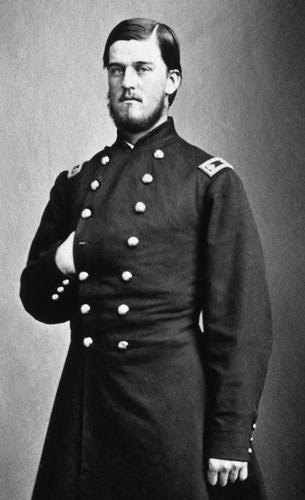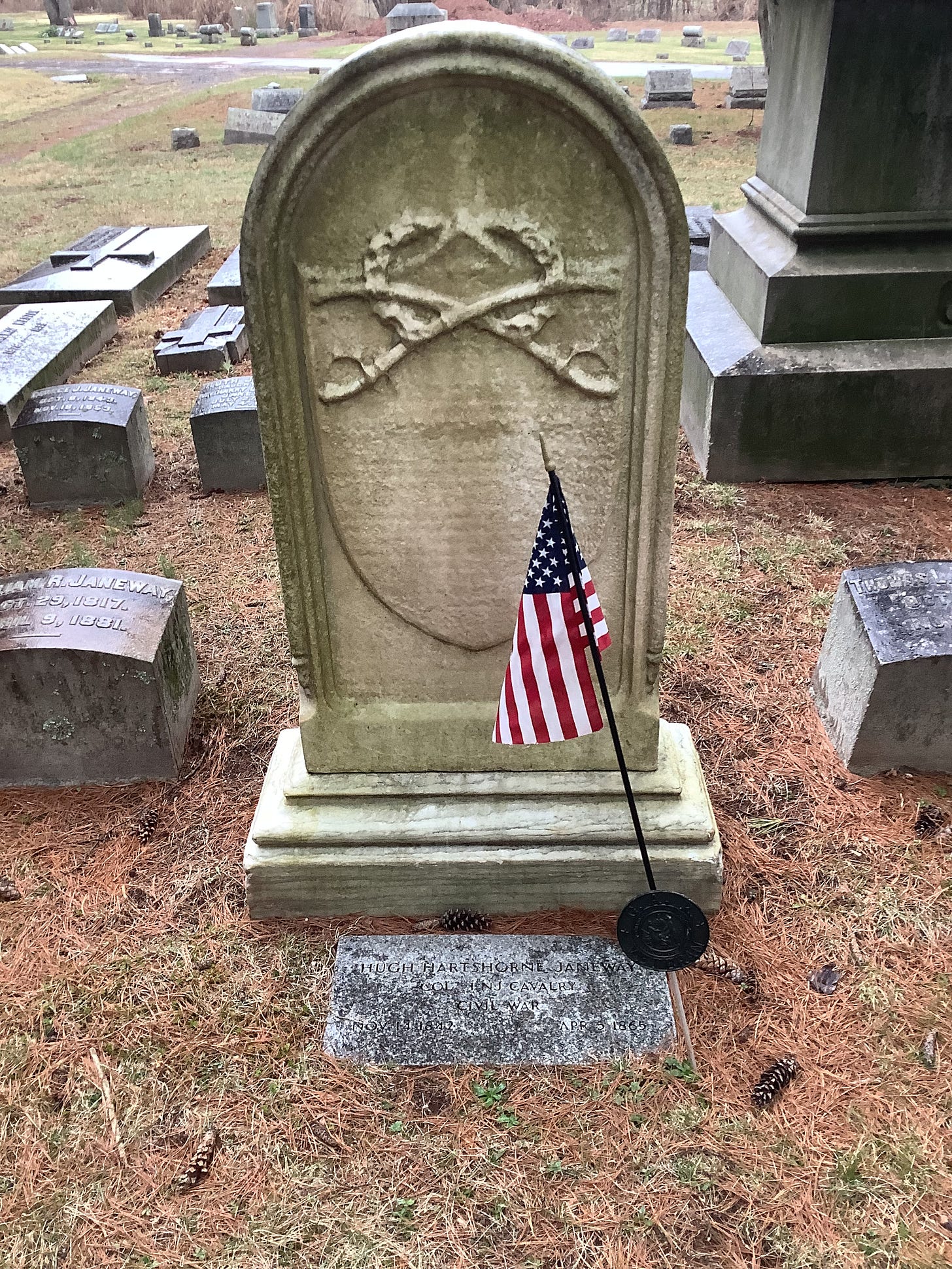This Saturday, weather permitting, we will be hosting our walking tour Battle Cry of Freedom: Stories of Those Who Served in the Civil War at 2:00 pm. One of our oldest and most popular tours, this tour highlights some of the most interesting and accomplished men interred at this cemetery. Elmwood was established in 1868, just three years after the end of the war, and consequently many Civil War veterans were laid to rest at the cemetery; we also have had many veterans who were slain before the establishment of the cemetery reinterred at the cemetery, such as the veteran I would like to highlight today.
Hugh Janeway didn’t live a long life, but he certainly lived an accomplished one. Readers may remember his name, as he and his family history were highlighted over the summer in an earlier blog post. While that blog post certainly gave as good a summary of his life as a single paragraph could, his story is far too interesting to leave it at that. As the first notable on our tour, we believe his story is one of the most interesting, patriotic and selfless among all of our veterans, and it seems appropriate to finally share the whole story.
It seems in some ways that Janeway’s whole life was leading up to his service in the Civil War. Apparently, Janeway had been riding horses his whole life, so it was unsurprising that he would desire to serve in a cavalry unit when the war broke out. There was just one problem for him, though: New Jersey did not immediately have a cavalry. Janeway and many other likeminded compatriots had rode to Trenton to offer their services, but there was little the state government could do. However, these would-be-volunteers did catch the attention of someone who did have some influence to create a cavalry.
William Halsted was a former congressman and attorney who had been involved in New Jersey politics for much of his life. By the time of the beginning of the Civil War, he was a vocal supporter of Governor Charles Olden, who was in office during the start of the conflict, and had allies in both the state and federal government. Wanting to have charge of his own regiment, he supported these men and lobbied, successfully, to have the First NJ Cavalry organized in August of 1861. At only age 18 Hugh Janeway would become a First Lieutenant in the Union army.
The First New Jersey Cavalry would become one of the most celebrated regiments to come out of the state and became known as “the fighting regiment.” Depending on how you count, the regiment was involved in as many as 95 battles during the course of the war. Janeway, who served the duration of the war, would see much of the action. Perhaps consequently, he would be injured 15 times during the war. In the interest of time, I won’t recount every single battle Janeway was involved in, but i will highlight one of the first major conflicts he participated in.
On December 18, 1861 the 1st NJ Cavalry was on reconnaissance to Pohick Church, Virginia. Janeway and an orderly would separate from the rest of his company, where they were surrounded by Confederates. They were fired upon, with Janeway being hit. The orderly was lucky to avoid getting shot, although his horse was killed. In the excitement he escaped, leaving Janeway behind with the enemy. The sound of the gunshots alerted the attention of Janeway’s company, causing the Confederates to flee, although not before looting Janeway of his small arms and clothing. Janeway was picked up by his comrades and as taken to the army doctor, where it was determined he was shot six times. Despite that, he would survive and would return to the field.
By the final year of the war, on October 11, 1864, Janeway had been promoted to Colonel. With this he became the main commander of the 1st NJ Cavalry, at only the age of 21. The 1st NJ Cavalry was part of General Grant’s troops participating in the final pursuit of General Lee’s army. 5 days before the surrender at Appomattox Courthouse, the 1st NJ Cavalry was fighting in Amelia Springs, Virginia. During the battle, Janeway ordered and then led a charge; tragically, at the beginning of this charge he was shot in the temple, killing him instantly. He was only 22.
To his fellow soldiers, his loss was felt widely. Some considered it the saddest moment of the war. He would be remembered on the 1st NJ Cavalry monument at Gettysburg, his name would be used for the local New Brunswick Grand Army of the Republic post, Kearney-Janeway Post No. 15. His image would later be used on a ribbon for a 1st New Jersey Cavalry Reunion event. Janeway would be well remembered locally.
His body was returned to the family rather quickly after his passing and they would have a funeral before he was interred in the family vault; later he would be interred at Elmwood. Unfortunately for him, the coverage of his funeral in New Jersey papers was reduced as the papers all carried the most significant news to occur the day of his funeral: President Abraham Lincoln had been shot and killed by an assassin’s bullet. Still Janeway’s memory has been preserved locally, as places like the New Brunswick Free Public Library and Rutgers University Archives maintain items from their collections relating to his life. Truly, while it was short, it was a life filled with great purpose.
Sources:
“1st Regiment, New Jersey Cavalry.” National Park Service. Accessed March 27, 2025. https://www.nps.gov/civilwar/search-battle-units-detail.htm?battleUnitCode=UNJ0001RC.
Clayton, W. Woodward. History of Union and Middlesex Counties. Philadelphia, PA: Everts & Peck, 1882.
Colonel Hugh H. Janeway of Co. L, 1st New Jersey Cavalry Regiment. United States, None. [Between 1861 and 1865, printed ca. 1898] Photograph. https://www.loc.gov/item/2023638944/.
“From Across the Potomac - A Reconnaissance,” The Baltimore Sun. December 18, 1861.
Jackson, William J. New Jerseyans in the Civil War. New Brunswick, NJ: Rutgers University Press, 2000.
Kull, Irving S. New Jersey - A History. Vol. III. New York, NY: American Historical Society, Inc., 1930.
Lee, Francis Bazley. The Genealogical and Memorial History of the State of New Jersey. New York, NY: Lewis Historical Publishing Company, 1910.
Maynard, W. Barksdale. “Princeton in the Confederacy’s Service.” Princeton University, March 23, 2011. https://paw.princeton.edu/article/princeton-confederacys-service.
“Monument to the 1st New Jersey Cavalry Regiment at Gettysburg.” Stone Sentinels. Accessed March 27, 2025. https://gettysburg.stonesentinels.com/union-monuments/new-jersey/1st-new-jersey-cavalry/.
“Obsequies of the Late Brevet Brigadier General Janeway.” The American Standard. April 15, 1865.
Personal War Sketches. Retrieved from https://doi.org/doi:10.7282/T30G3JMR.
Pyne, Henry R. History of the First New Jersey Cavalry, (Sixteenth Regiment, New Jersey Volunteers). Trenton, NJ: J.A. Beecher, 1871.
“The State’s War Heroes.” The Trenton Times. August 23, 1883.
Stockton, R.F. Report of the Operations of the First New Jersey Cavalry, From the 28th of March to the 25th of May, 1865, With a Portion of the Number of Engagements in Which the Regiment has Participated, and a Complete Roster of the Commissioned Officers. Trenton, NJ: True American Office, 1865.
“Struggle without End: New Jersey and the Civil War.” Rutger University Libraries, accessed March 27, 2025. https://exhibits.libraries.rutgers.edu/struggle-without-end/appomattox.





